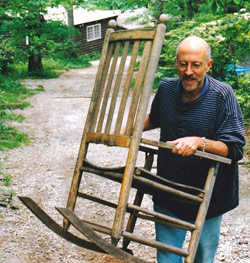This is the fifth, and final, in a series of articles about altars republished from the Visionary archives. It was originally published in the Summer 2001 issue of GSV’s Visionary journal.
My Little Altar
By Andrew Ramer

The small wooden chest beside my bed comes from a Danish Modern wall unit that my father and his second wife purchased in the mid 1960’s. I got it in 1975 when I moved to my first apartment in Brooklyn. The vertical supports didn’t reach the ceiling of my hundred-year-old brownstone so I put them out on the street, along with all the bookshelves. But I kept the chest and it’s been my meditation altar ever since.
A succession of objects have sat on top of this chest, with only one constant feature: a pair of brass Sabbath candlesticks that my mother’s mother’s mother brought here from Russia.
[pullquote align=”left” cite=”” link=”” color=”” class=”” size=””]In the middle of my earliest altar, created when I was 5, were two ceramic figurines I was in love with, a cowboy and an angel. They no longer exist, except in a blurry photograph.[/pullquote]
Around and between them have been crystals, feathers, shells, beach rocks, post cards, photographs, icons, statues of goddesses, gods, animals, angels and often – nothing. Today a glass hand sits between the candlesticks. To the right of it are a brass egg, a crystal on top of a polished lapis disk my mother gave me and a statue of two metal flute players sent to me by Sister Who. To the left are the silver kiddish cup my father’s father sipped his wine from on the Sabbath, a tiny glass globe of the earth, and a plastic deer that I bought in Cliff’s hardware and variety store on Castro Street for $2.29
In the middle of my earliest altar, created when I was 5, were two ceramic figurines I was in love with, a cowboy and an angel. They no longer exist, except in a blurry photograph. Arranging altars has always been calming and focusing for me. Long before I ever heard the word “meditation,” I would sit in front of my altar; tuning into … something. The objects remind me of things that are important, the burning candles still my senses and the blank white wall behind the altar has always been a source of rest. As a firm believer in disorganized religion, I do not sit and meditate every day at my altar. But Its there all the time, generating an energy field that I can slide into when I need it.
I also have altars on top of both of my toilet tanks and on a kitchen shelf. My public altar is in the living room, on top of two larger chests from the same old wall unit my bedroom altar came from. It is covered with icons, kachinas, menorahs, Buddhas, Zuni fetishes, rocks and more candles. Some of my friends think it’s a coffee table and put their cups on it when I have a party.
This article was originally published in the Summer 2001 issue of GSV’s Visionary journal. Read the original article in the Visionary.



 My daily practice is Yoga, breathing, Chi Gung, meditation and Planetary Acupuncture. Decades ago I studied Yoga with the Pierce Program in Atlanta with Martin Pierce’s first Men’s Class. Then for several years I attended a “Wellness Workout” taught by Jean Dunham that combined breathing, stretching, Skinner Releasing and dancing. Here I was also introduced to the Tao Animal Exercises in which you “become” different animals to energize different body systems.
My daily practice is Yoga, breathing, Chi Gung, meditation and Planetary Acupuncture. Decades ago I studied Yoga with the Pierce Program in Atlanta with Martin Pierce’s first Men’s Class. Then for several years I attended a “Wellness Workout” taught by Jean Dunham that combined breathing, stretching, Skinner Releasing and dancing. Here I was also introduced to the Tao Animal Exercises in which you “become” different animals to energize different body systems.
